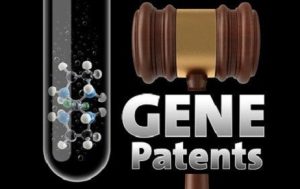Introduction What is Artificial Intelligence? Creating computer systems capable of carrying out activities that need…
Gene Patenting In India
There has been a great advancement in technology after the revelation of the structure of the DNA molecule. Since then, scientists have engaged in efforts of identifying the sequences of these molecules, their function and also in manipulating them to achieve desired results.

Patentability of Genes
The Patents Act under Section 3(c) specifies that the mere discovery of a scientific principle or the formulation of an abstract theory, discovery of any living thing or non-living substance occurring in nature would not be patentable.
Section 3(i) states that plants and animals, in whole or any part thereof, other than microorganisms but including seeds, varieties and species and essentially biological processes for production or propagation of plants and animals – cannot be patented.
A gene which is occurring in nature and is not patentable as per Section 3(c). However, it must be noted that considerable amount of skill is involved in identifying the function, location and isolation of gene.
The question therefore arises weather genes be considered a part of plant or animal and therefore will not be patentable? Secondly, what can make these genes patentable? There is no direct answer to these questions in The Indian Patent Act, 1970.
The exclusion of parts of animals or plants ought to be taken seriously as this exclusion is phrased different from the TRIPS provision which excludes plants and animals but there is no specific provision for its parts. Therefore, we need to examine the Patent Practice Manual issued by the Indian Patent Office.
The 2005 draft manual specifically had an annex dedicated to biotechnological and pharmaceutical inventions. This draft stated that any living entity of artificial origin such as transgenic animals and plants and any part thereof are not patentable. The living entities of natural origin such as animals, plants, in whole or any parts thereof, plant varieties, seeds, species and genes are not considered patentable. It also stated that recombinant DNA and plasmids are patentable if there is substantial human intervention.
No such annexure was present in the subsequent draft in 2008. The Dimminaco decision,[1] gave support to explanation under Section 3(j) which only describe how microorganisms will be patentable.
However, under the description of unity of an invention: the manual provides the following example –
When a genetically modified gene sequence/amino acid sequence is novel, involves an inventive step and has industrial application, the following can be claimed: –
- Gene sequence/amino acid sequence
- A method of expressing above sequence
- An antibody against that protein/sequence
- A kit made from the antibody/sequence
The actual Manual of Patent Practice and Procedure which was released in 2011 does not provide any further elaboration on the subject matter. The only provisions that were retained were the ones pertaining to sequence listing that had to be provided by the patentee and the above-mentioned bullet list under ‘unity of an invention’. The manual did not provide a place for the requirement of substantial human intervention.
Genetically Stable JEV cDNA based on Japanese Encephalitis Virus
The original title of the invention states that it is related to the ‘novel genomic RNA’ of the JEV and an infectious cDNA from it. However, the final granted patent’s title reads as follows ‘Genetically stable JEV cDNA based on Japanese encephalitis viruses.’
This could possibly lead us to conclude that there might have been an objection (however, not to be found in the records accessible on the official website) which led to the amendment of the claims, the title, the abstract to cover the cDNA instead of the RNA. Therefore, it is possible to claim cDNA sequences as a part of a patent in India.
Therefore, the IPO has given a wider protection to the cDNA sequence than any other of its offices, even though it is a mere derivative of the existing sequence.
An Isolated Nucleic Acid Molecule Comprising an Allele of a Genetic Polymorphism Linked to Resistance to Enterotoxigenic Escherichia Coli (ETEC)
This is a patent where the subject matter nucleic acid sequence pertains to resistance to a particular type of E. coli in pigs. The invention covers methods to identify this sequence using probes and primers crafted for this purpose. The first claim covers the particular sequence that results in the trait of resistance in pigs, and as such is naturally occurring. The patent covers both the original sequence and the other man-made probes/primers for identifying the trait. The first examination report does not raise any objection to either the animal source of the gene/the fact that the first claim refers to an isolated gene sequence.24 This thus concludes that animal genes are patentable in India.
In the recent Monsanto Technology LLC v Nuziveedu Seeds Ltd[2] case, the Division Bench of the High Court of Delhi held that “genetically modified plants, genetically modified seeds and gene sequences that provide genetic traits to plants are not patentable subject matter in India”. The Division Bench’s decision was subsequently set aside by the Apex Court of India owing to the complexity of issues and the need for a re-examination of evidence. The Apex Court did not make any concluding remarks relating to the patenting of isolated DNA and cDNA. Therefore, making the Indian Position unclear on the matter.
Conclusion
When the IPO officials were generally asked about their practice with regard to gene patents – it was stated that genes that do occur in nature are not patentable. Because Section 3(c) and (d) prescribes as to what are not patents and the following provisions put a bar on patenting of a naturally occurring gene. Thus, those genes which do occur in nature are not patentable.
As far as non-naturally occurring genes are concerned, once there is a delineated function or utility specified, they will become patentable. Because they pass the test of as to what is can be patented
Novelty – Genetic engineering and application of advanced Biotechnology to obtain a desired result.
Utility – research and development of medicinal or other purposes having utility for public at large, It has industrial application and a market value.
Non-Obviousness – Direct use of Human gene doesn’t involve any new innovative step and the information is already in the public domain but making an enhanced Gene, non-naturally occurring increasing the efficacy, by changing the genetic information or making significant changes or modifications in the upstream or downstream.
Also, it is mentioned that the exclusion referring to plants/animals/parts of plants or animals are not applicable at the molecular/cellular level where genes are involved.
Author: Sampada Kapoor (intern) – a student of LLM (IPR) from Amity University, in case of any queries please contact/write back to us via email chhavi@khuranaandkhurana.com or contact us at IIPRD.
References:
[1] Dimminaco A.G. v. Controller of Patents and Designs, (2002) I.P.L.R. 255 (Cal)
[2] AIR 2019 SC 559



